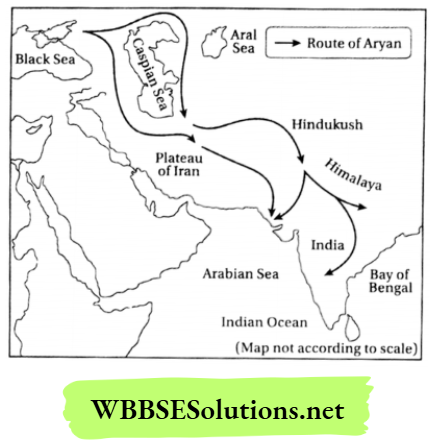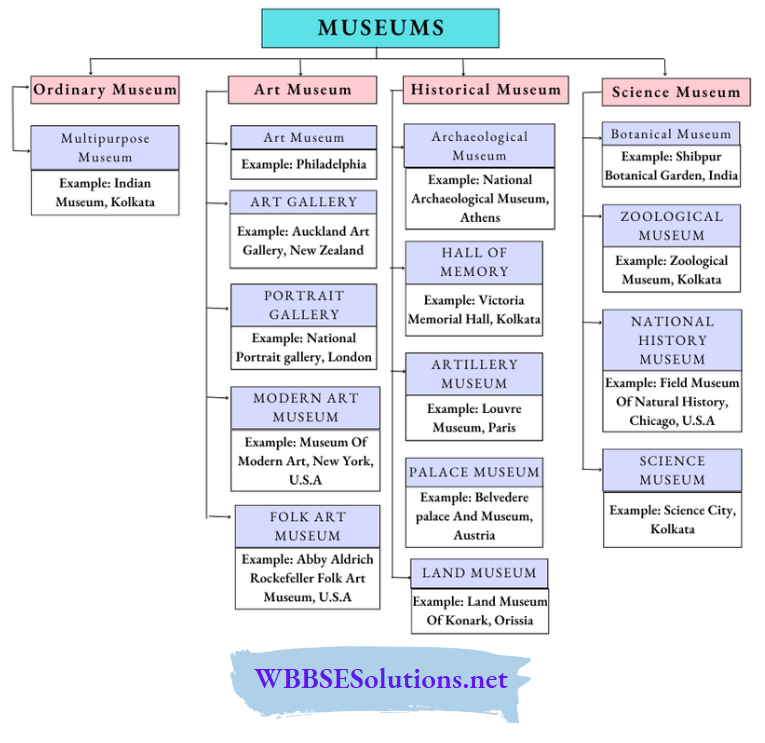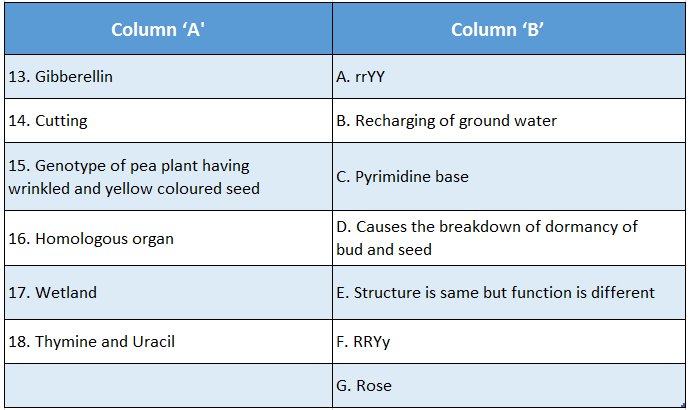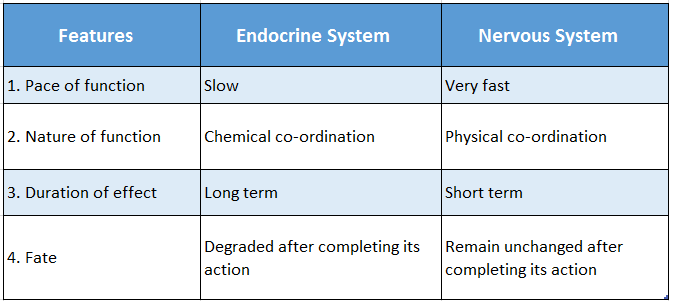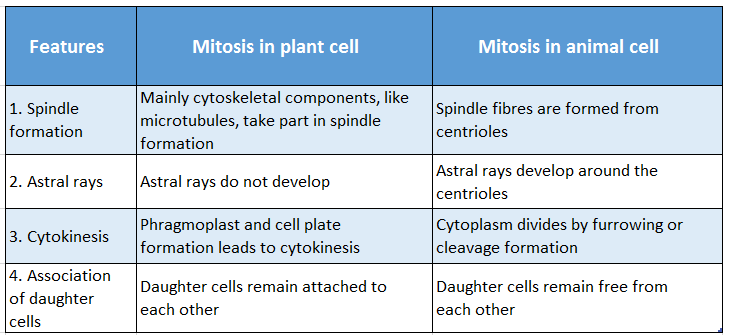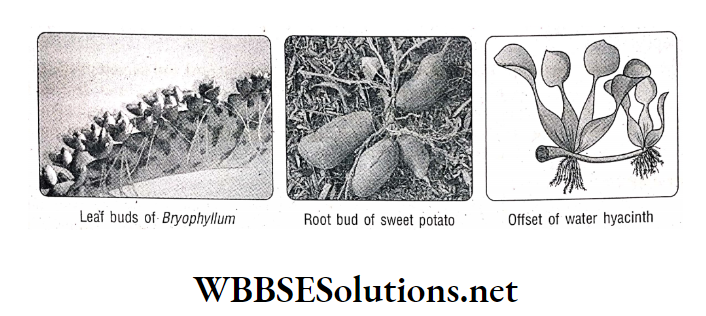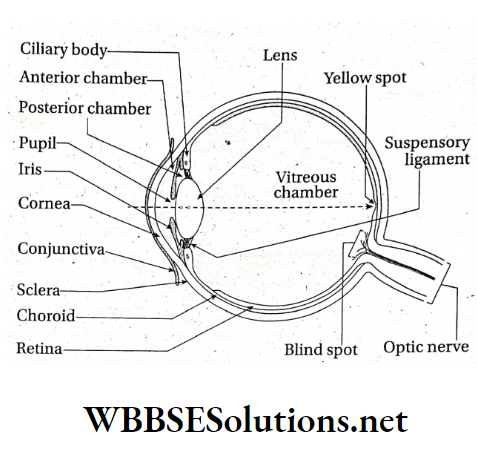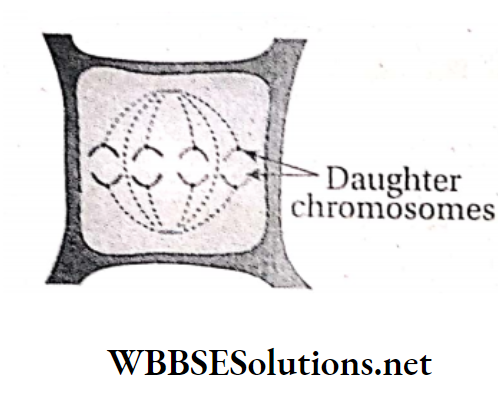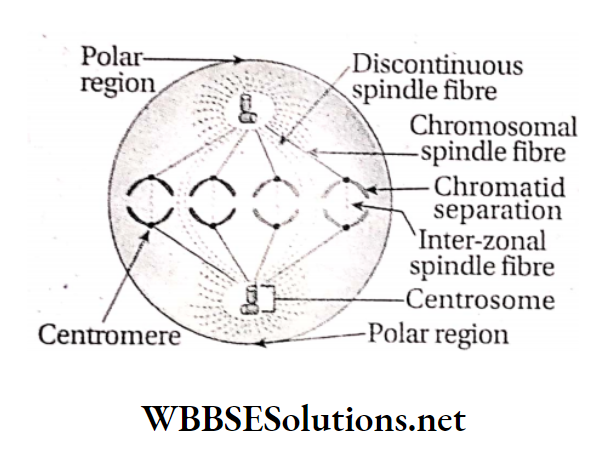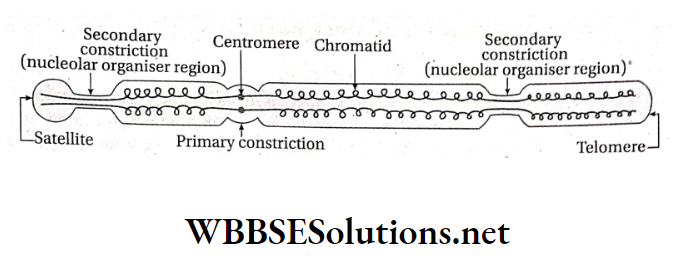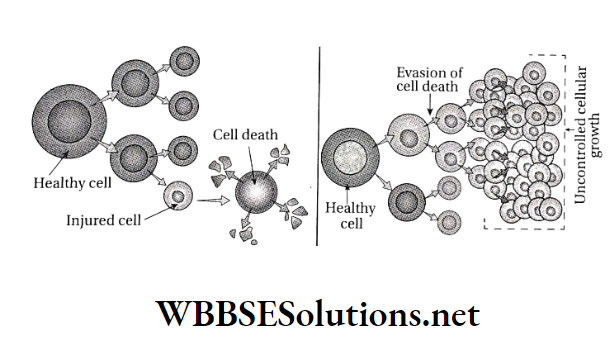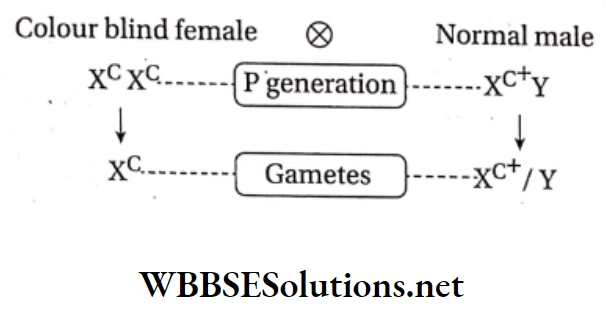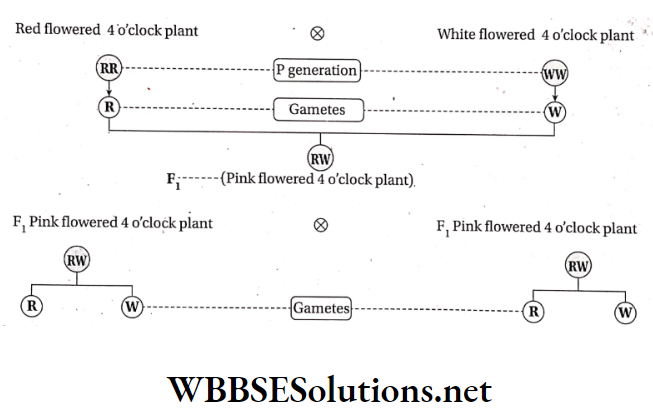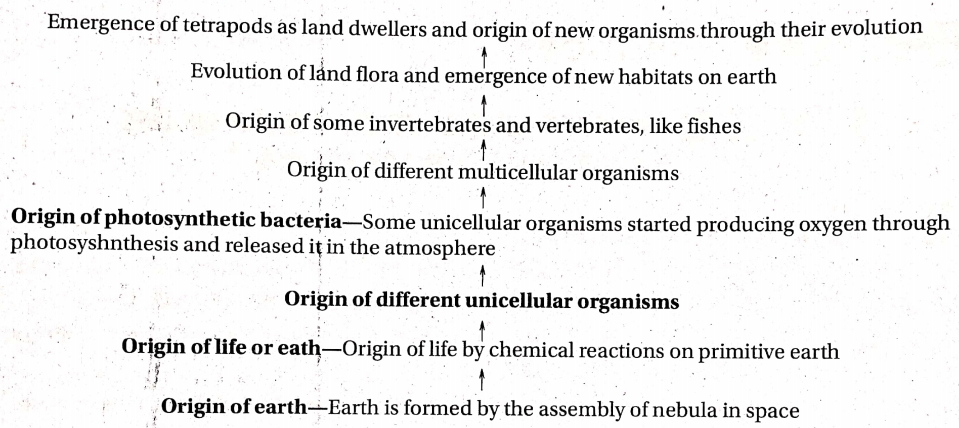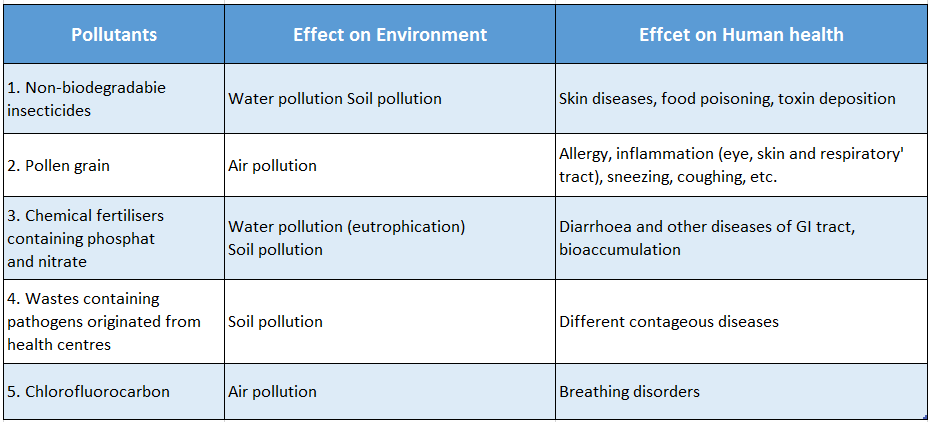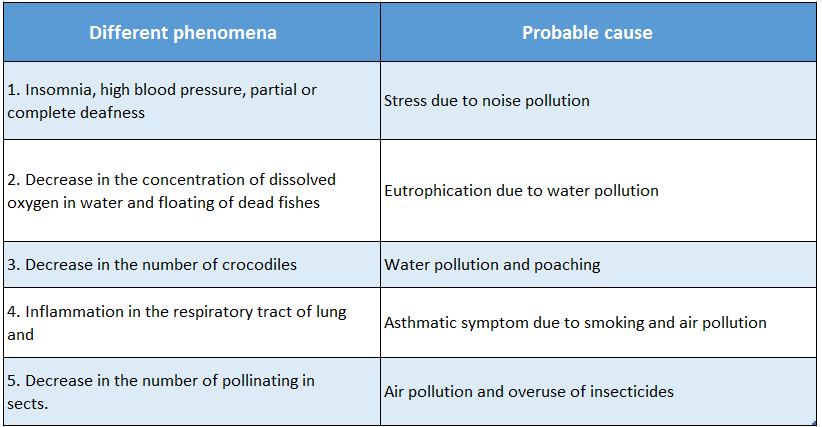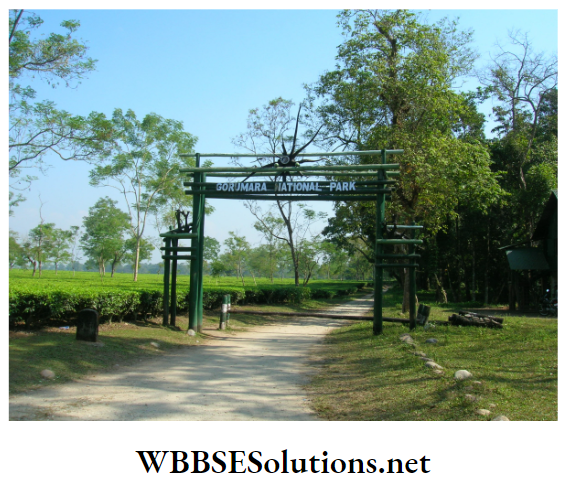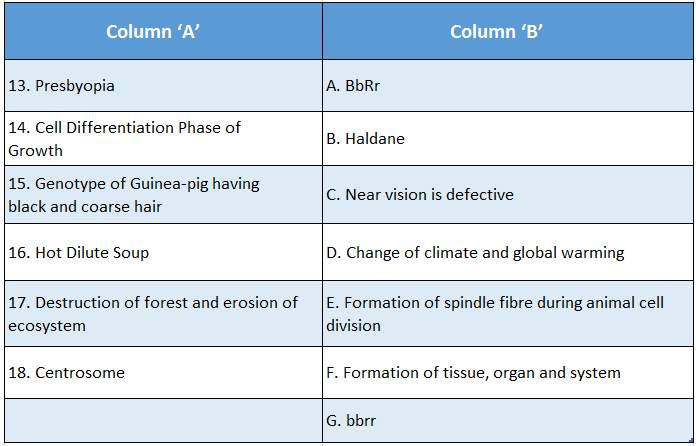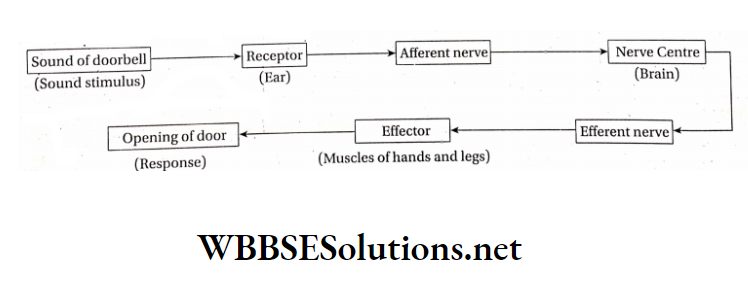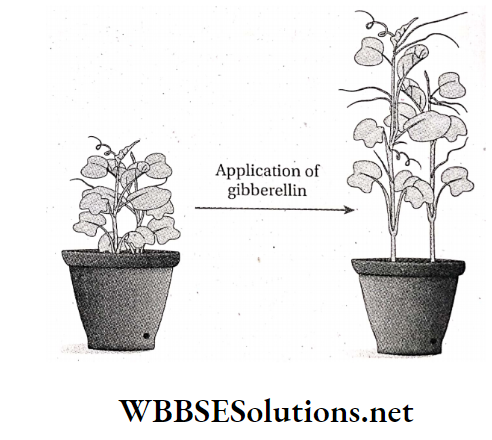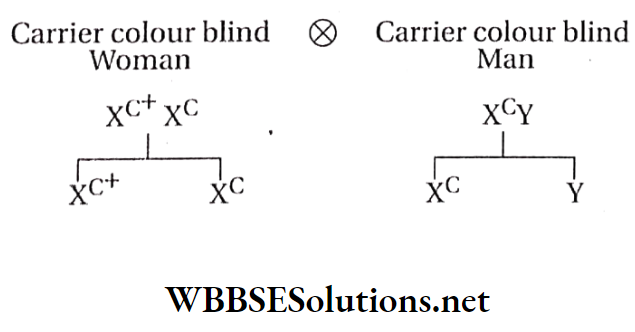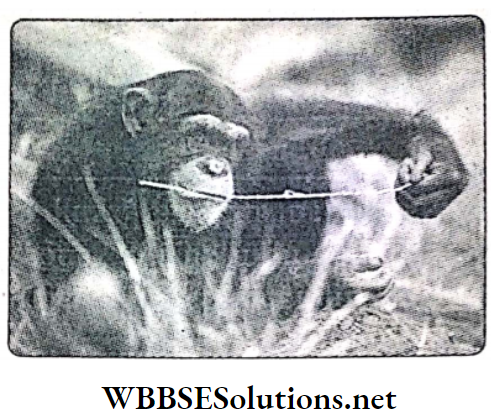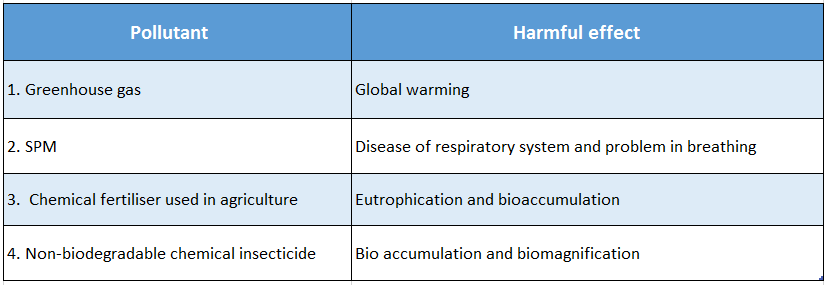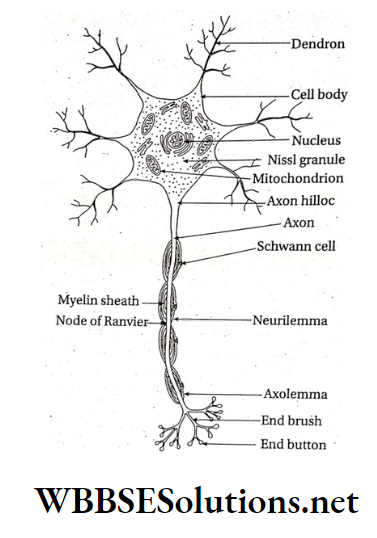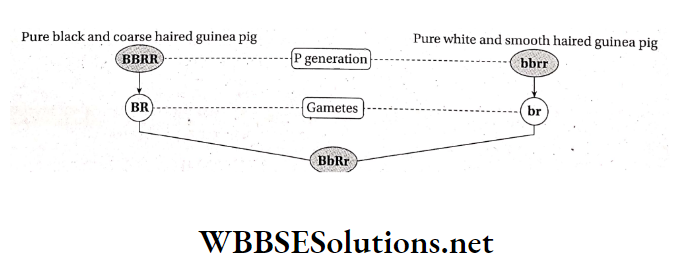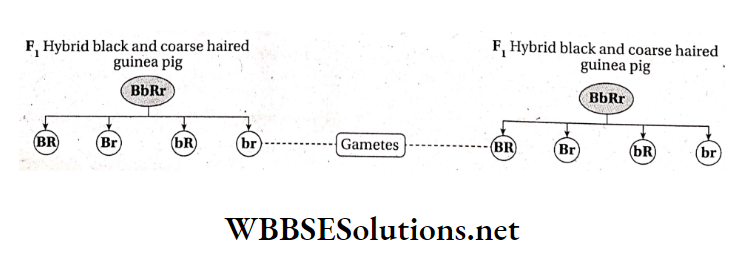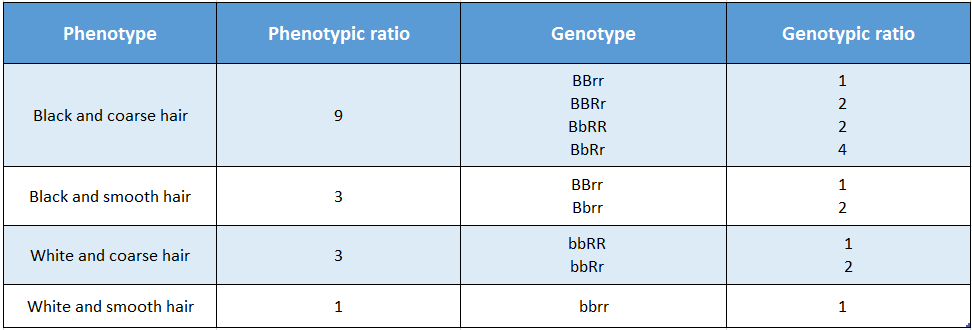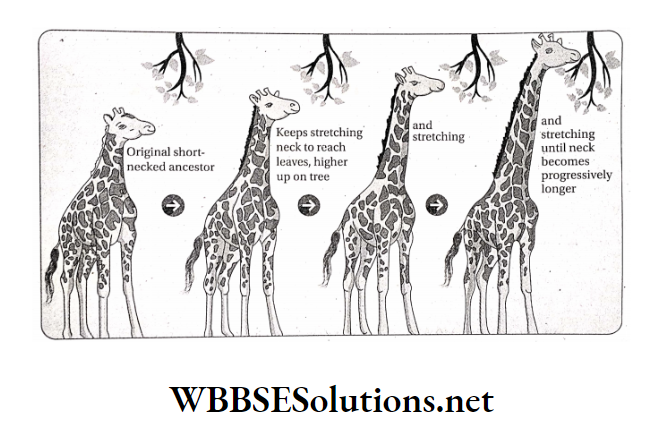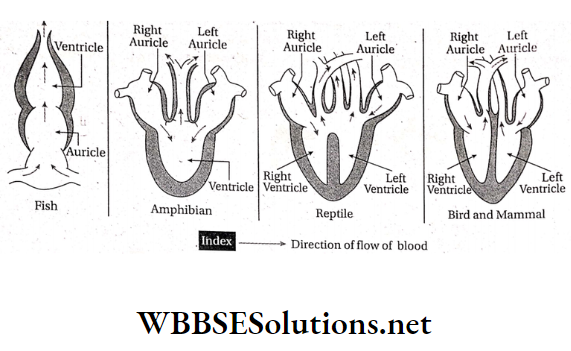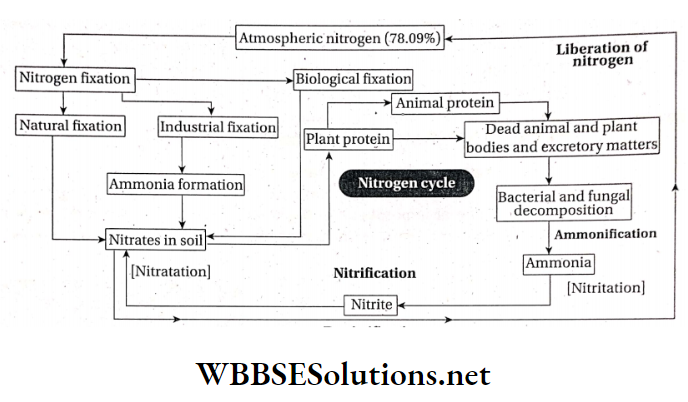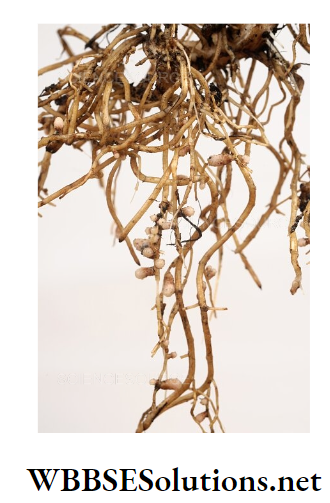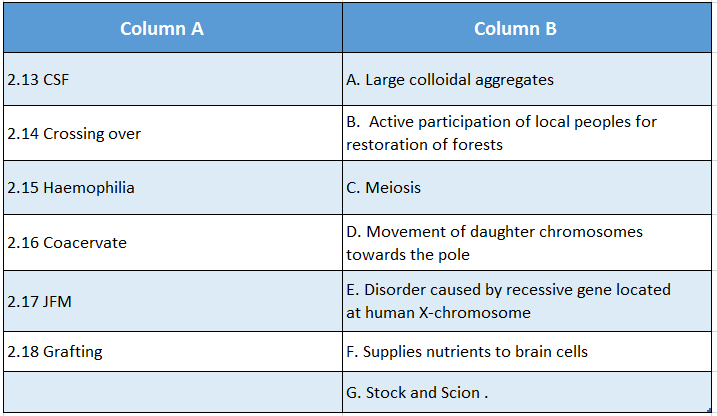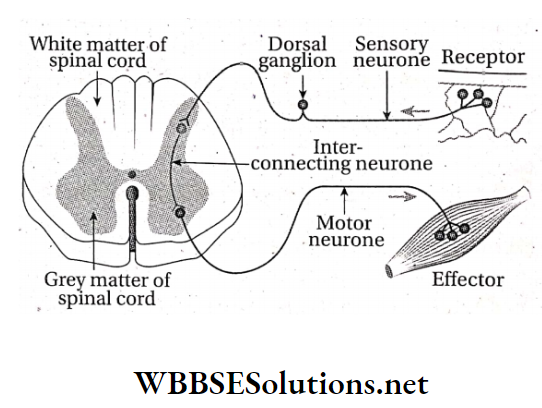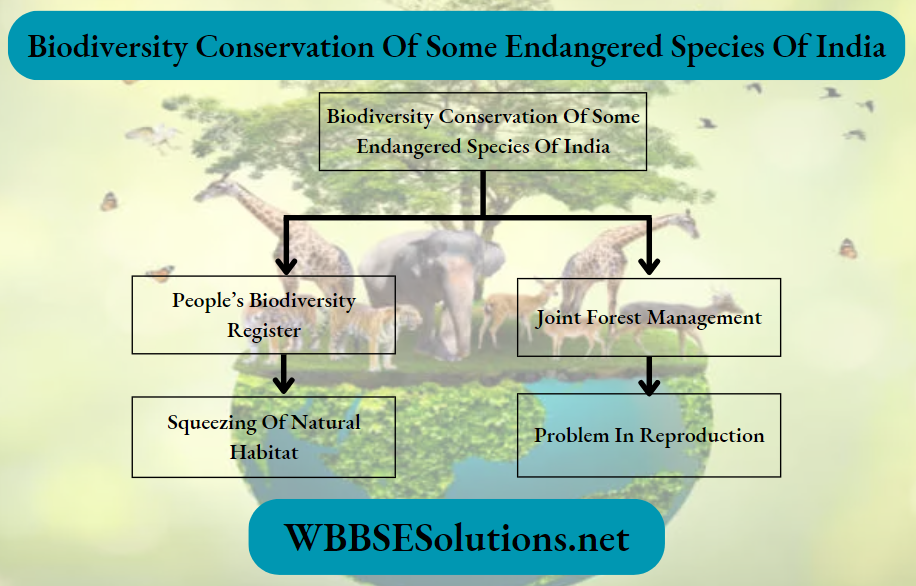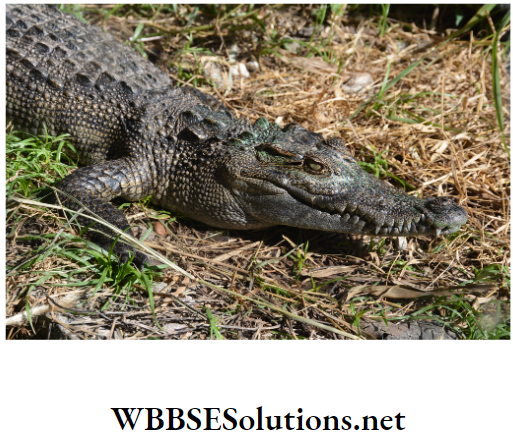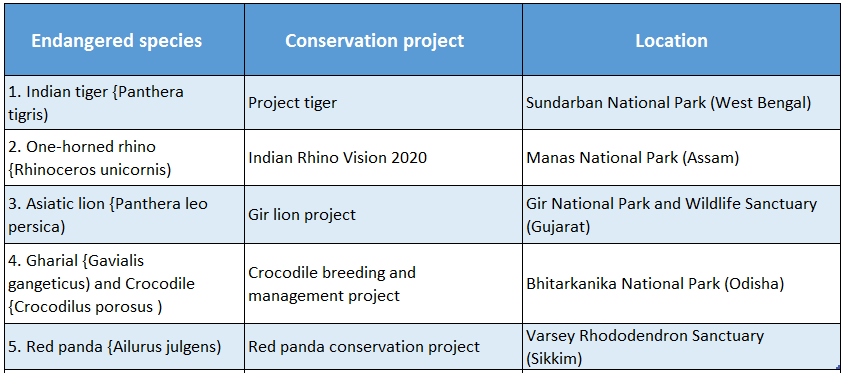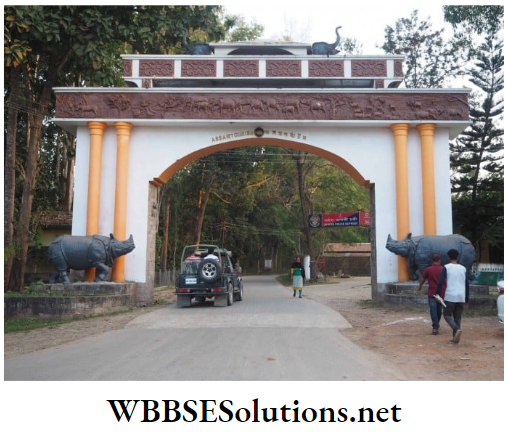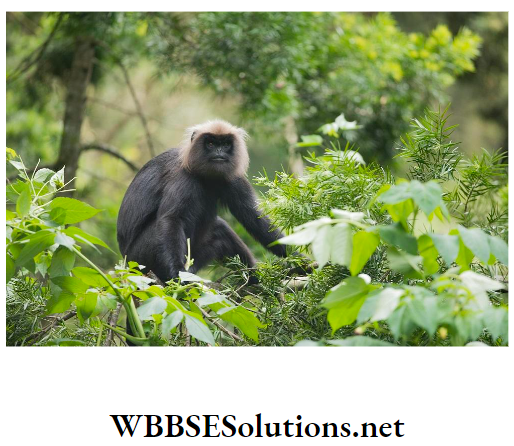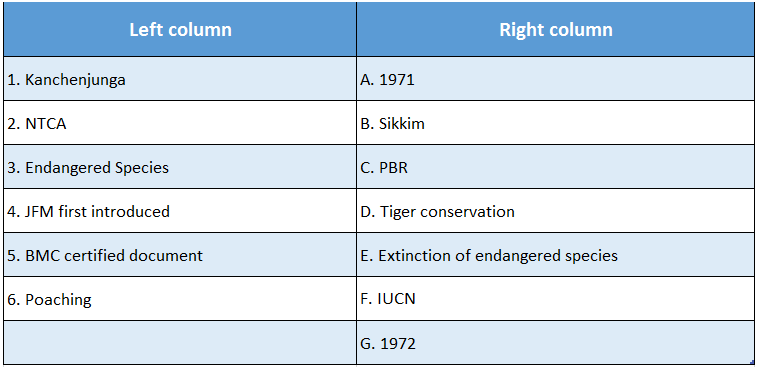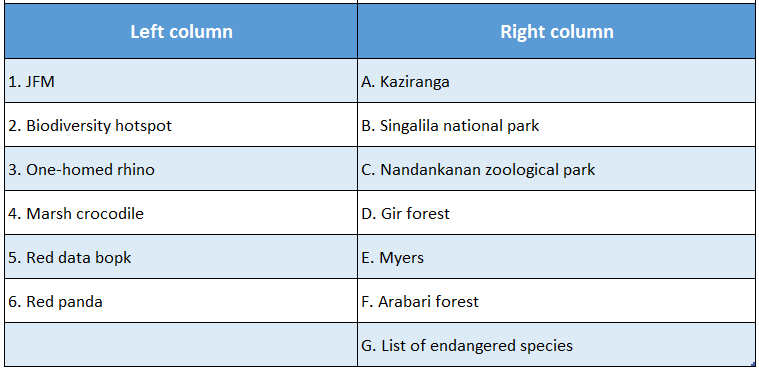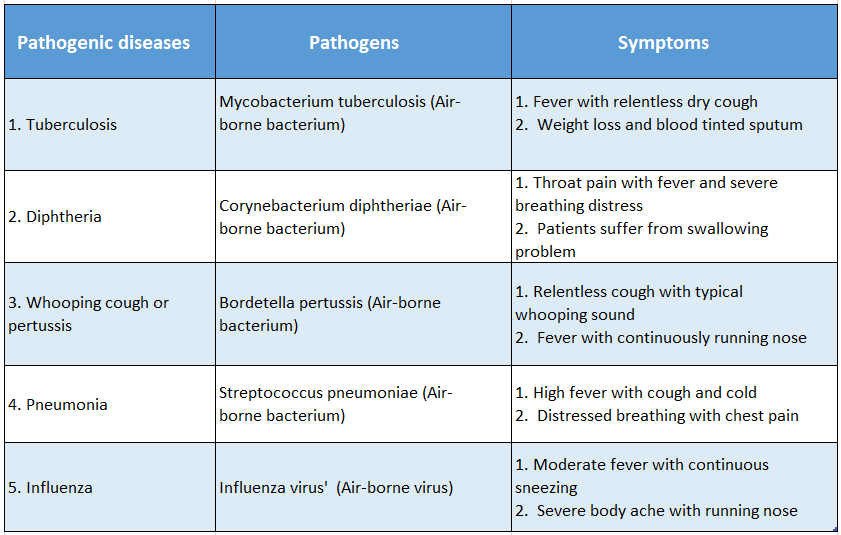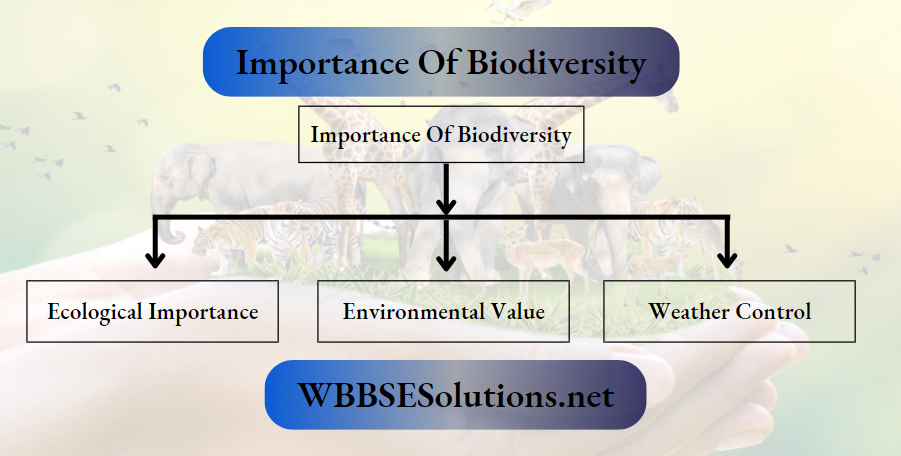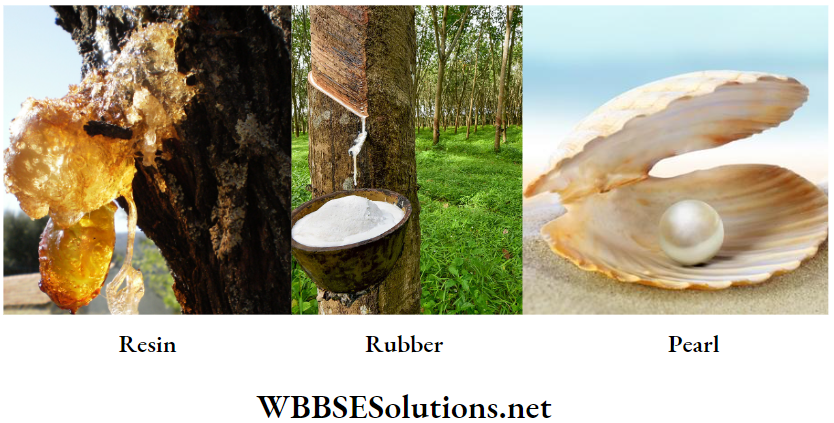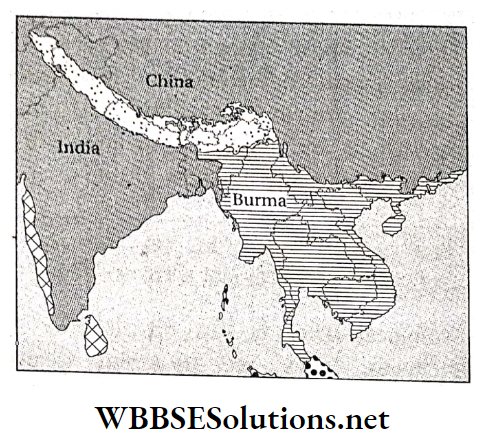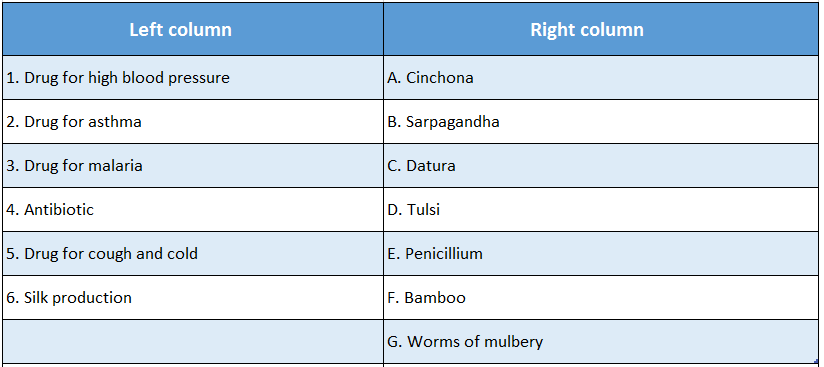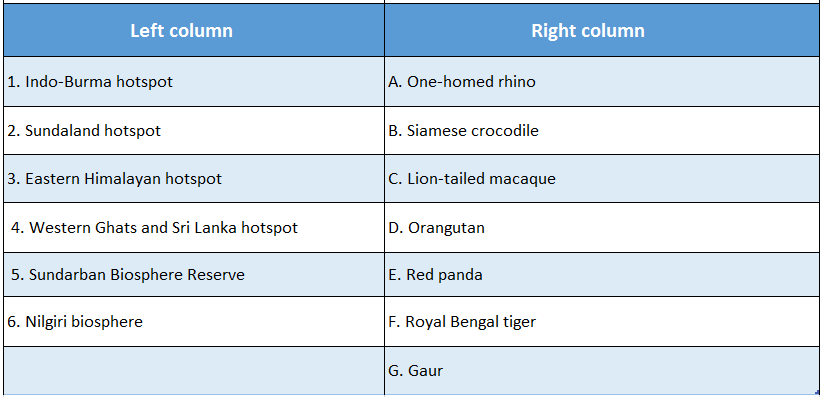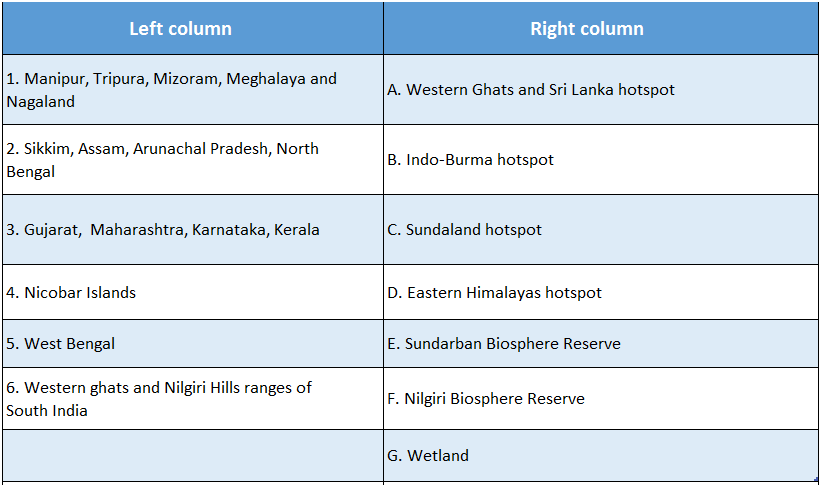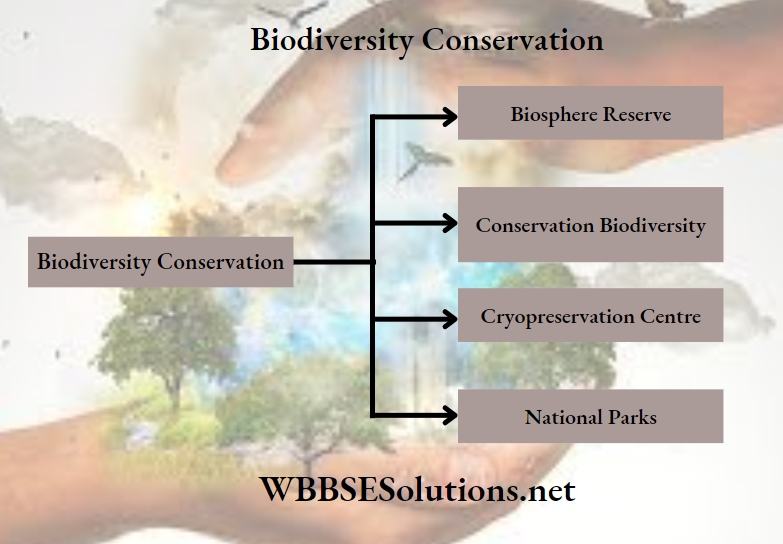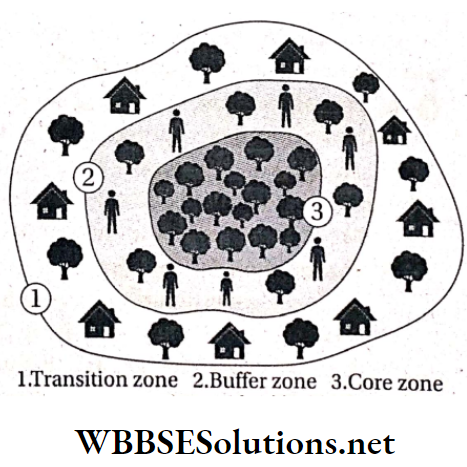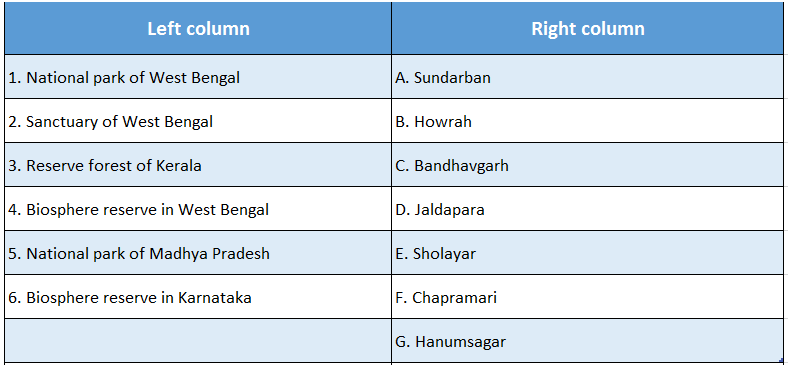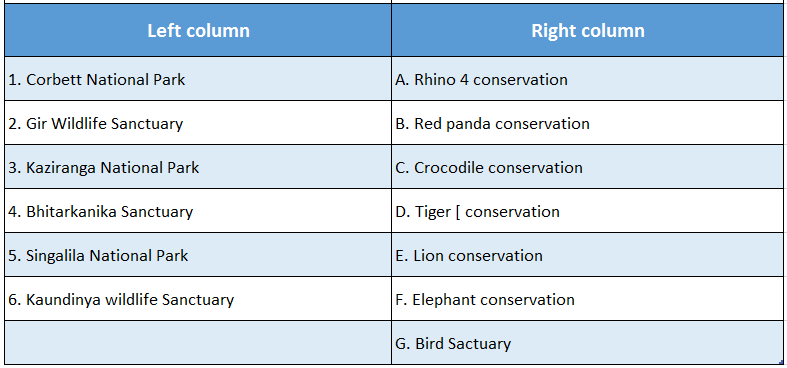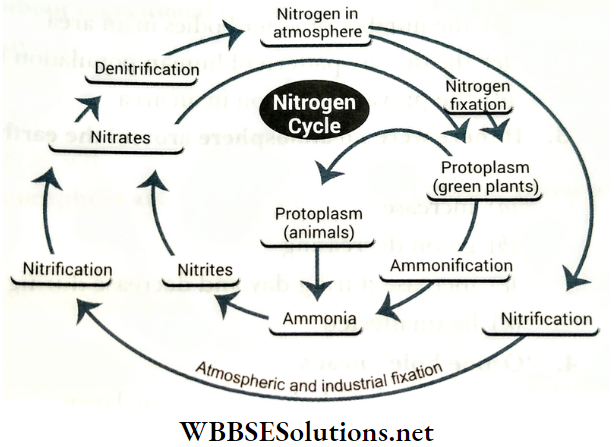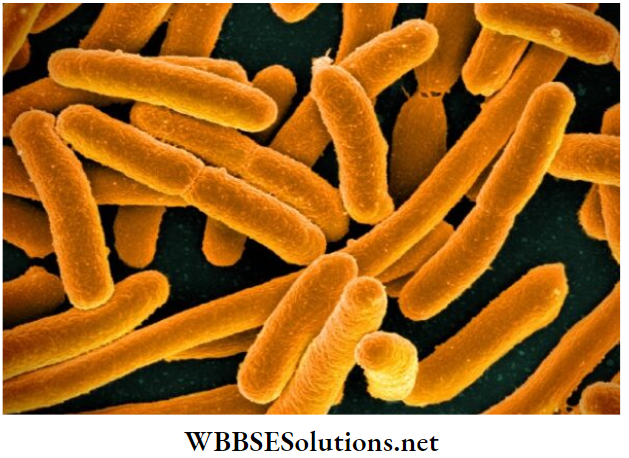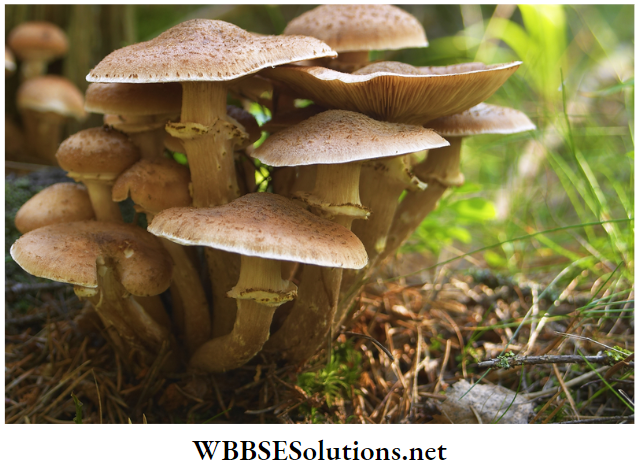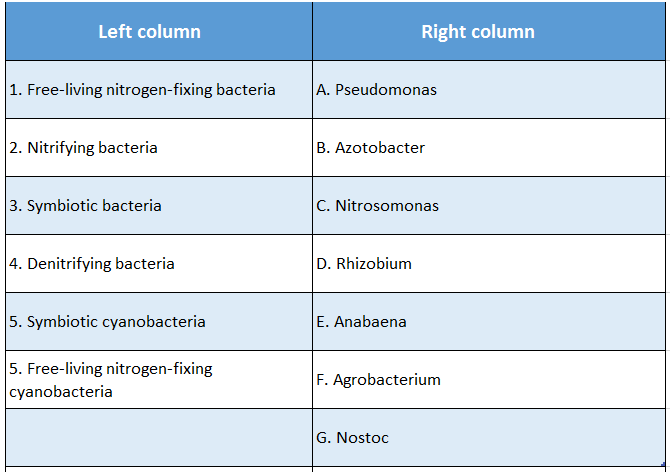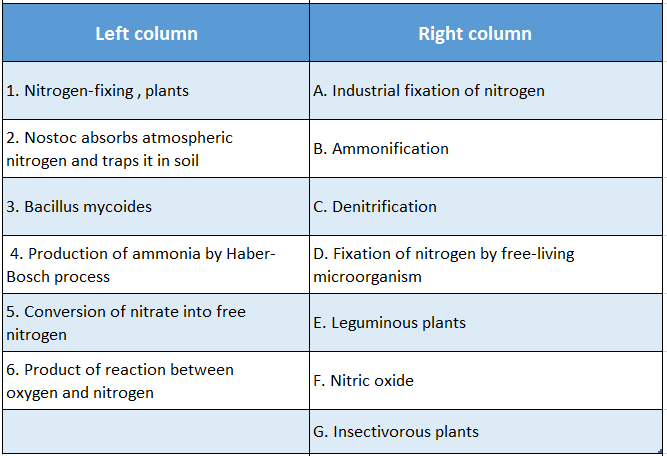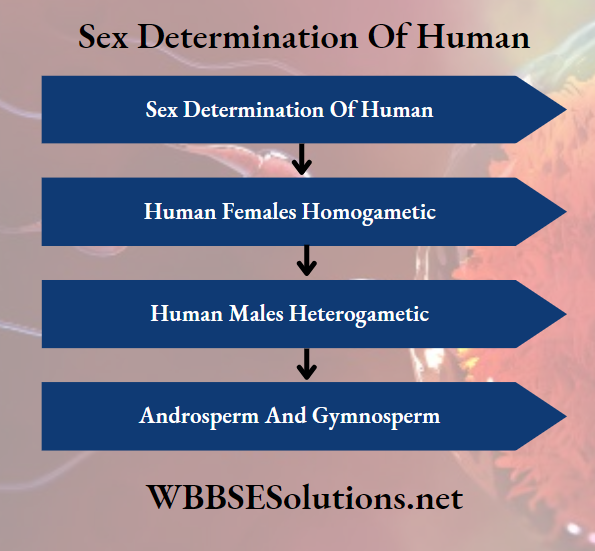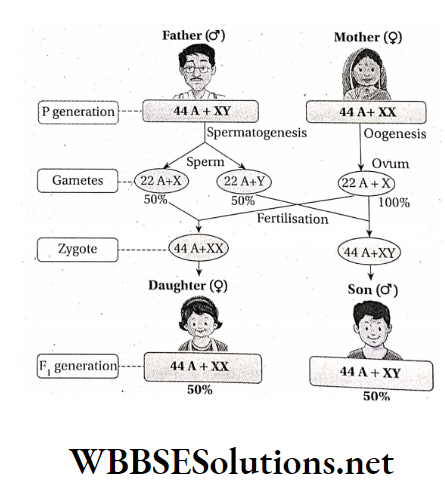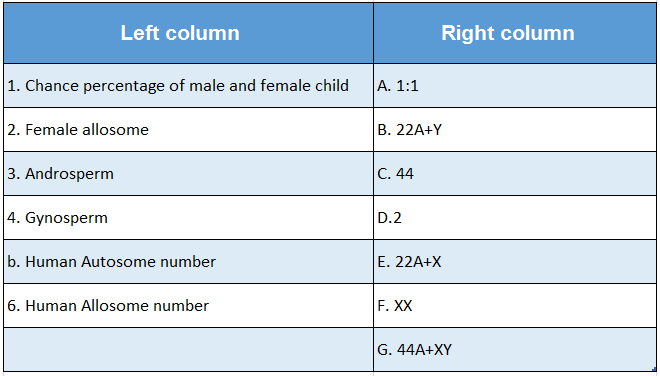Chapter 4 Adaptation Summary
WBBSE Class 10 Adaptation Overview
- The reaction of an organism in response to environmental stimuli is called its behaviour. Behaviour helps in the adaptation and evolution of an organism.
- Adaptation is the structural or functional changes of an organism which help the organism to survive in a new environment or their constantly changing current environment.
- Morphological adaptations can be observed in the followings-
-
- The leaves of some desert plants turn into spines, even the number of leaves also decreases. These are to reduce the rate of transpiration in water deficit conditions.
- The air bladder is the buoyancy organ in fish which helps the fish to maintain its depth while swimming.
- Air sacs in birds help them by increasing oxygen exchange capacity and lessen the specific gravity of birds thus enabling them to fly higher.
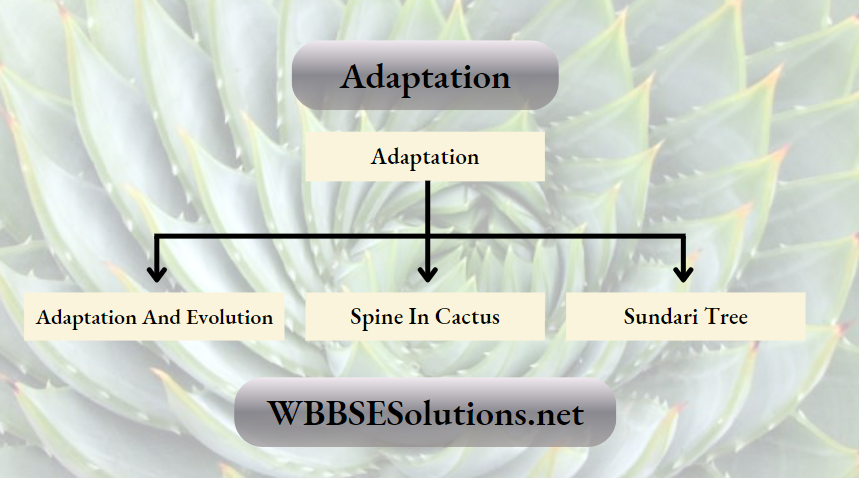
Wbbse Class 10 Life Science Solutions
- Physiological adaptation is observed in the Sundari plant, camel, etc. Removing excess salt by bark exfoliation and through salt glands present in leaves, conducting oxygen intake via pneumatophore, etc. are some physiological processes which enable the Sundari plant to survive in coastal saline soil.
- RBC of the camel is small, oval and can expand up to 240% after water absorption. Besides, water production by oxidizing the fat stored in the hump, releasing concentrated urine, etc. help camel to survive in the extreme condition of a desert region.
- Chimpanzees and honey bees show behavioural adaptation. Chimpanzees prepare sticks from twigs and use these as fishing tools to extract termites from their mound and eat them. They use rocks as a hammer to break the shells of nuts.
- When they get infected by parasites they use herbs as medicines to treat themselves. Honey bees perform typical patterns of dance, like waggle dance, and circular dance, to indicate the direction and distance of food source from the hive.
Read and Learn More WBBSE Solutions for Class 10 Life Science And Environment
Chapter 4 Adaptation Long Answer Type Questions
Question 1. What is the relation between adaptation and evolution? Mention the functions of the spine in the cactus to combat the arid environment.
Answer:
Relation between adaptation and evolution:
Adaptation is the evolutionary process which enables an organism to survive in its habitat.
1. Adaptation-a step to evolution:
To survive in a changing environment, organisms change their morphological, behavioural and physiological features accordingly. Those, which can adjust themselves successfully in a changing environment, get the favour of natural selection to survive and propagate.

The favourable adaptive features are inherited by successive generations, which help in the origin of a new species or assist in evolution. Practically, adaptation is a step towards evolution.
Wbbse Class 10 Life Science Solutions
2. Evolution-a greater notion:
Evolution is a very long and complex process. It is a continuous, ongoing process, since the origin of life on Earth. On the other hand, adaptation occurs when any organism faces any problem related to its survival due to any change in the environment.
Therefore, evolution is a greater notion in comparison to adaptation.
Functions of the spine in cactus:
The main functions of the spine in cactus are as follows-
- The spines are modifications of leaves which are transformed to prevent transpiration.
- Spines also act as defence organs against herbivores.

Question 2. What is the importance of air sacs in pigeons? Write down the role of the air bladder in rohu fish in maintaining body balance in the water. Part question, Prepare a list of roles air sacks of pigeons to play to fly in the air.
Answer:
Importance of air sacs in pigeons:
Pigeon is a primary volant animal. It has nine non-vascular and non-muscular air sacs, emerging from the bronchioles, typically helping in flight.
The importance of air sacs in pigeons are-
- During the flight, the pigeon needs extra energy, the production of which requires additional oxygen. Oxygen concentration near the ground level is higher than that in the high sky. Before the flight, pigeons fill the air sacs with this oxygen-rich air. When in the high sky, these air sacs supply oxygen-rich air to the lungs.
- The air-filled sacs decrease the specific gravity of the body of the pigeon, which is also beneficial for flight.
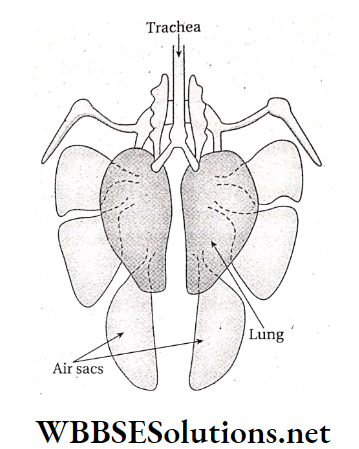
Importance of air bladder in rohu fish:
- The air bladder in rohu fish helps it to move up and down in the water. The air bladder changes the buoyancy of the body and thus, assists it to go at different depths of water.
- The red gland in the anterior chamber of the air bladder fills gas in it to reduce the specific gravity of the body and thus helps the fish to move upward in water. On the other hand, the rete mirabile of the posterior chamber absorbs the gas to increase the specific gravity of the body of fish and helps the fish to go deeper in the water.
Types of Adaptations in Plants and Animals
Question 3. Briefly describe the adaptive features of the Sundari tree.
Answer:
Adaptation of Sundari tree:
Sundari trees grow in saline muddy soil at coastal regions or river delta. This soil is rich in mineral salts. The oxygen content of this saline soil is also very low. Halophytes, like Sundari trees, have the following adaptations for surviving in this soil.
1. Adaptive changes in roots:
- To get adequate oxygen from the soil for the root system, several lateral branches of roots grow against gravity and emerge vertically above the soil. These aerial roots have numerous pores on the surface to absorb atmospheric oxygen. This type of root is called a pneumatophore.
- Sundari trees have plank-like lateral projections, called root buttresses, extending from the root base to support the tree from all sides to stand on soft soil. This type of root in Sundari trees helps the plants to stand erect on muddy soil at the coastal region.

2. Adaptive changes in stem:
- The surface of the stem is coated with a thick and waxy cuticle layer. This coating prevents transpiratory water loss through the stem surface.
- For better transportation of water and food, their vascular system is highly developed.
3. Adaptive changes in leaves:
- The number of stomata is reduced and the existing stomata are sunken to reduce the rate of transpiration.
- Leaf lamina is covered with a waxy substance to prevent transpiration.
Question 4. Mention the physiological adaptations of a camel. Part question, How the special feature of RBC in camels is related to their ability to withstand the extreme loss of water?
Wbbse Class 10 Life Science Solutions
Answer:
The physiological adaptations of camel:
Camel is one of the best-adapted animals in desert environments. The adaptive features of a camel with respect to the conservation of water and modification of RBC are mentioned below.

1. Adaptive features helping in the conservation of water:
- The hump on the back of the camel reserves fat, which is oxidised to produce water and energy during their long walk through the desert.
- Camels discharge highly concentrated urine to conserve water.
- A camel can drink up to 36 litres of water at a time, which is stored in the water reservoir cells of its stomach.
- The mucous membrane of the nasal passage absorbs moisture from the air that the camel exhales.
- Body temperature of the camel changes in accordance with the external temperature, which reduces perspiration water loss, even at a high temperature of 49° Celsius.
2. Adaptive modifications of RBC:
- The RBCs of camel are very small and oval in shape. This modification facilitates the movement of these blood cells through finer blood capillaries even at very low water content in plasma.
- When plasma contains adequate water, the RBCs of camels can expand up to about 240 times of its normal size, by absorbing water by endosmosis. These cells can withstand high osmotic pressure and do not rupture even after the intake of a huge quantity of water at a time.
Question 5. Why is behaviour important for evolution? Mention three different behaviours of chimpanzees, which help in their adaptation.
Part question, Give an example of ways chimpanzees solve their problems intelligently for procuring food and preventing diseases.
Part question, Explain how do the chimpanzee hunt termites for food. Part question, How do chimpanzees break open the hard shells for eating the nuts?
Answer:
Importance of behaviour in evolution:
Organisms show neurally controlled reactions in response to any visual, auditory or olfactory signals or any stimulus, like light, sound, smell or any action by other organisms. These responses are called behaviour.
The favourable behaviours which help an organism to survive and propagate on earth, are selected by nature. The effect of these behaviours is so far-reaching that it may help in the course of evolution.

Adaptive behaviours of chimpanzees:
- Chimpanzees break branches of trees and then eat up the leaves to prepare a stick. With the stick, they make a hole in a termite mound. Then, they insert the thin stick into the mound to tease the termite colony inside it. As soon as the termites grab the probing stick, chimpanzees pull it out and lick them up. Few termites, which come out through the hole are eaten up by other chimpanzees. This particular behavioural adaptation of chimpanzees is known as termite fishing.
- When a chimpanzee is attacked by parasites, it starts eating medicinal plants. Scientists revealed that chimpanzees can recognise and consume 19 different medicinal plants including Aspilia rudis, when attacked by parasites.
- To crack hard nutshell, wild chimpanzees use a piece of rock as an anvil and a strong branch of the tree as a hammer. They keep hard-shelled nuts on the rock and then hammer it with the woody branch to crack it. Finally, they remove the shell and eat the nut inside.
Wbbse Class 10 Life Science Solutions

Question 6. Describe with a diagram how honeybees pass messages to other members of the hive about the source of food.
Or,
How a worker bee of a beehive communicates with other worker bees, regarding the source and location of food?
Answer:
Indication of honeybees about the source of food:
In a honeycomb, there are two types of worker bees, of which, scouts go in search of food and foragers fetch nectar. When any scout bee finds a source of food, it returns to its hive and performs a typical pattern of dance in front of the foragers to pass the message.
There are two patterns of bee dances, waggle dance and circular dance, which are discussed below.
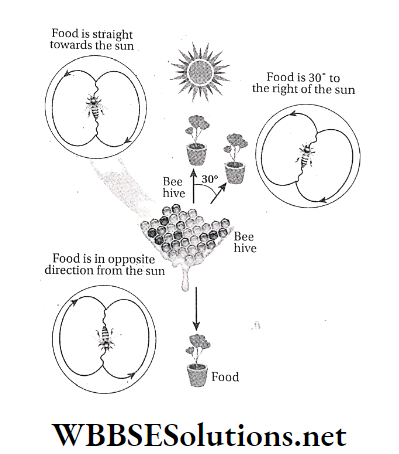
Examples of Adaptation in Nature
1. Waggle dance:
If the source of food is at a distance of more than 75 metres, scout bees perform a typical dancing flight, known as the waggle dance.
In this dance, they fly in alternate left and right directions to create an ‘8’ shaped course and at the straight middle portion of the course, jerk the abdomen. An upward flight indicates that the source of food is along the direction of the sun.
When the source of food is at the opposite direction to the sun, they perform the dancing flight in a downward direction. If they get the source at an angle of 30° from the hive, they perform the waggle dance at the same angle as the axis of the hive.
2. Circular dance:
When they find the food at a distance within 50-75 metres, the scouts perform the circular dance. As soon as the message is passed to the foragers, they leave the hive in a swarm and fly towards the source of food.
Chapter 4 Adaptation Short Answer Type Questions
Question 1. What is adaptation?
Answer:
Adaptation:
Adaptation is the morphological, physiological or behavioural adjustment of an organism to survive in a changing environment. Survival of any organism in a habitat depends upon its perfect adaptation to that environment.
Question 2. What is the objective of adaptation?
Answer:
The objective of adaptation:
The main objective of adaptation of an organism is to survive in a changing environment. The adaptation may be a morphological, physio- logical or behavioural adjustment with its surrounding environment.
Question 3. Adaptation is the change of shape, physiological functions and behaviour of an organism’-Justify the statement with the help of any two examples.
Answer:
Adaptation is the change of shape, physiological functions and behaviour of an organism:
The canine teeth of carnivorous animals are large and sharp to tear flesh whereas the same are relatively small and blunt in herbivores. This change in the shape of the teeth helps the organisms to consume particular types of food.
Kangaroo rats survive without drinking water for a long time, camels possess some physiological adaptations that allow them to survive a long time without drinking water. These are examples of physiological changes which help the animals to adapt in the desert environment.
Camouflaging is a behavioural adaptation of certain organisms to hide in any particular environment. So it can be called that is the change in shape, physiological function and behaviour of organisms.
Question 4. What is acclimatisation?
Answer:
Acclimatisation:
The physiological changes occurring in the organisms in accordance with the changes in its environment are collectively called acclimatisation.
For example, people living at high altitudes, have higher RBC count in blood and greater total lung capacity to acclimatise with low oxygen density in the atmosphere.
Question 5. What is meant by behaviour?
Answer:
Behaviour:
Behaviour simply refers to the expression of any organism in an environment. It can be defined as the neurally controlled reaction, shown by an organism in response to any environmental signal or any specific stimulus or any action by other organisms.
Question 6. How is behaviour related to the environment?
Answer:
Behaviour is related to the environment in the with the environment by its own behaviour.
Following ways-
- Every organism coordinates
- The behaviour of an organism changes in accordance with the change in the environment.
Question 7. What is ethology?
Answer:
Ethology:
The branch of science that deals with the study of the behaviour of different animals, from small insects to large mammals, is called ethology. By studying ethology, one can have an idea on the nature of the expression of an animal in response to any external or internal stimulus.
Question 8. Distinguish between adaptation and evolution.
Answer:
The distinguishing features between adaptation and evolution are-
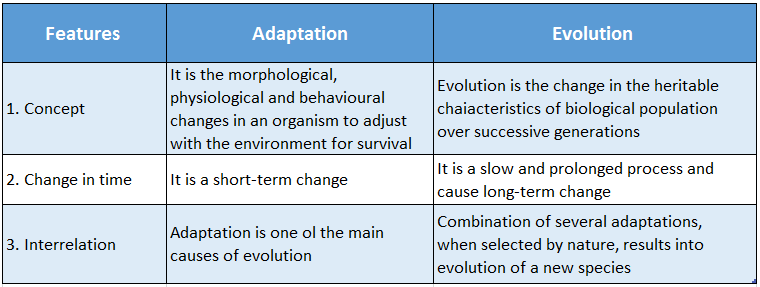
Question 9. What is the relation between behaviour and evolution?
Answer:
The relation between behaviour and evolution:
The behaviour of any organism helps it to survive and propagate in nature. As the environment changes, the organisms also change their behaviour to adapt in it.
If these changes are selected by nature and propagate to the next progeny for several generations, new species evolve that possess this changed behaviour.
Question 10. Define morphological adaptation and give an example.
Answer:
Morphological adaptation:
The permanent and beneficial physical changes, occurring either internally or externally in the body of an organism to help it survive in a changing environment, are called morphological adaptation.
Example-Modification of leaves of cactus into spines is an example of morphological adaptation.
Question 11. What is meant by xerophytic adaptation?
Answer:
Xerophytic adaptation:
The morphological and physiological changes, which occur in plants to befit them in arid environments, are collectively known as xerophytic adaptation. This adaptation is seen in desert plants, like cacti, babul, Aloe vera etc.
Question 12. Which plants are called xerophytes?
Answer:
Xerophytes
The plants, which are adapted to survive in physically dry soil and in the atmosphere with very low moisture content, are known as xerophytes.
Wbbse Class 10 Life Science Solutions
Example- Cactus, Asparagus, babul, etc.
Question 13. Which adaptive features are seen in cacti to reduce water loss due to transpiration?
Answer:
To reduce water loss by transpiration, the following adaptations are seen in cacti-
- The size and number of leaves reduce. Sunken stomata are present in leaves.
- In some cacti, leaves are modified into spines to reduce the rate of transpiration.
- The phylloclade is covered with cuticle to seal stomata thus preventing water loss.
Question 14. Which morphological structures modify into spines of cactus and thorns of wood apples?
Answer:
Spines of cactus are the modification of leaves. On the other hand, the thorns of wood apples are a modified form of axillary buds.

Question 15. Who are the primary aquatic animals?
Answer:
The primary aquatic animals:
The aquatic animals, which have evolved from aquatic ancestors, are called primary aquatic animals. Example-Generally all fishes are primarily aquatic animals.

Question 16. Who are called secondary aquatic animals?
Answer:
Secondary aquatic animals:
Certain animals which had terrestrial ancestors but have adapted themselves to aquatic life for certain reasons, are called secondary aquatic animals.
Example-Whale, sea cow, etc.
Question 17. Mention two aquatic adaptations of fishes.
Answer:
Two aquatic adaptations of fishes are as follows-
- Fishes have air bladders to move in different depths of water.
- To swim in different directions and maintain balance in the water, fishes have different types of fins.
Question 18. What are the roles of the swim bladder in the aquatic adaptation of rohu fish?
Answer:
The roles of the swim bladder in the aquatic adaptation of rohu fish
The swim bladder or air bladder in fish is a gas-filled internal organ and acts as a hydrostatic organ. It can increase or decrease the buoyancy of a fish by respectively increasing or decreasing the volume of gas within it.
Thus, an air bladder helps a fish to go up to different depths of water without floating upward or sinking downwards.
Wbbse Class 10 Life Science Solutions
Question 19. What is rete mirabile?
Answer:
Mirabile:
Rete mirabile is a network of blood capillaries in the posterior chamber of the air bladder of fish. It absorbs gas from the air bladder to increase the specific gravity of the body of a fish and helps it to go deeper in the water.
Question 20. What problems a fish would have faced if it lacked a spindle-shaped body and lateral line sense organ?
Answer:
If a fish lacked a spindle-shaped body, it would have faced more physical resistance while swimming. If there had been no lateral line sense organ, a fish could not have felt pressure, temperature and depth of water.
Importance of Adaptation for Survival
Question 21. Who are called primary volant animals?
Answer:
Primary volant animals:
The animals, adapted to aerial life, which have descended from flying ancestors, are called primary volant animals.
Example-Pigeon, bat, etc.

Question 22. Who are called secondary volant animals?
Answer:
Secondary volant animals:
There are certain volant animals, which have evolved from non-flying ancestors. These animals are called secondary volant animals.
Examples- Flying fish, flying squirrels, etc.
Question 23. How is the body shape of a pigeon modified for flying?
Answer:
For a flying bird-like pigeon, an aerodynamic body shape is needed. This body shape helps to overcome air resistance during fast flight. Hence pigeon has become spindle-shaped. to overcome the air-resistance, the body of a
Question 24. Mention the roles of air sacs in the volant adaptation of pigeons.
Or,
What are the two adaptive significances of air sacks of pigeons?
Answer:
The roles of air sacs in the volant adaptation of it needs more supply of oxygen to generate extra pigeons are
- Pigeon is a volant animals; hence energy during its flight. The air sacs, attached to its lungs, supply extra oxygen and therefore this process enhances the ability of the lungs.
- These air sacs hold air to reduce the specific gravity of its body during flight.
Question 25. What will happen to a pigeon if its air sacs become inactive?
Answer:
If a pigeon has inactive air sacs, it will face the following problems-
- Body weight will increase and double respiration will not occur.
- Body balance and centre of gravity of body will get disrupted during flight.
- It will not be able to collect highly oxygenated air from ground level to use it during high flight.
Question 26. Which organs have disappeared from the pigeon’s body to make it lighter?
Answer:
For flying, an animal always requires a lighter body. So to make the body of a pigeon lighter, certain organs have disappeared. These organs are teeth, gall bladder, rectum, right ovary and fallopian tube in females and penis in males.
Question 27. Define physiological adaptation and give an example.
Answer:
Physiological adaptation:
The permanent and beneficial changes in various physiological activities of an organism to facilitate its survival in a changing environment, is called physiological adaptation.
Example-Development of pneumatophores in the Sundari tree is an example of physiological adaptation.
Question 28. Which plants are called halophytes?
Answer:
The plants, growing in the saline soil of the coastal areas or delta regions, are called halophytes. Example-Sundari, garan, Hetal, etc.
Question 29. Mention two adaptive features of the Sundari tree.
Answer:
Two main adaptive features of Sundari tree are-
- Presence of specialised root structures known as pneumatophores.
- A thick layer of cuticle on the stem surface and leaves with fewer stomata to minimise water loss.
Question 30. How Sundari plant excretes the excess salt of its body? Similar question, Mention one adaptation of the Sundari plant for salt tolerance.
Or,
Describe any two adaptations in the Sundari plant for tolerance of salt.
Answer:
The mechanisms used by Sundari plant to excrete the excess salt from its body are-
- Presence of salt gland in the leaf to excrete excess salt along with water,
- Deposition of excess salt in specialized cells of bark and root; later, by means of bark exfoliation and other specific mechanisms, the salt are eliminated from the plant body,
- Deposition of salt in mature leaves, in larger amounts, so that it can be eliminated easily by leaf exfoliation,
- Deposition of excess salt in the cell sap of vacuoles and eliminate it when needed.
Adaptation Mechanisms in Extreme Environments
Question 31. What are pneumatophores?
Answer:
Pneumatophores:
Halophytes, like Sundari, Garan, etc., grow in highly saline and muddy soil with very low oxygen content. To get adequate oxygen for the root system, some lateral branches of their roots grow against gravity and emerge vertically above the soil.
These aerial roots have numerous pores on the surface to absorb atmospheric oxygen and such roots are known as pneumatophores or breathing roots.
Question 32. How do pneumatophores help Sundari trees to adapt in saline soil?
Answer:
Sundari trees grow in highly saline muddy coastal soil. This type of soil has very low oxygen content and water logging during high tide is very common in this region. Therefore, the root system does not get enough oxygen.
Pneumatophores are aerial roots which are negatively geotropic, thus helping Sundari trees to absorb aerial oxygen for the root system and help these plants to survive in the low oxygen-containing saline soil.
Question 33. What is meant by viviparous germination?
Answer:
Viviparous germination:
The process of seed germination where the seed germinates within the fruit while it is still attached with the plant is known as viviparous germination. Saline soil is not conducive for the germination of seeds.
To overcome this obstacle, viviparous germination Occurs in halophytes, like garan, Rhizophora, etc.
Question 34. What is the advantage of viviparous germination?
Answer:
The advantage of viviparous germination:
In viviparous germination, the seed germinates within the fruit and the radicle comes out of it as a pointed dagger-shaped structure even before its shedding from the tree.
As it grows some inches long, the fruit drops from the branch and the pointed tip of the radicle penetrates the soft soil keeping the developing embryo above the saline soil. Thus, viviparous germination protects the developing embryo from a hostile environment.
Question 35. Why Sundari tree is called a ‘looking glass tree’?
Answer:
Sundari tree is called a ‘looking glass tree’:
The leaves of Sundari trees are covered with a thick cuticle layer and a thin and smooth layer of wax coating. Besides, the lower surface of the leaves have numerous glossy silvery hairs.
When sunlight reflects from these leaf surfaces, it gives a beautiful glassy look, hence Sundari tree is called a ‘looking glass tree’.
Wbbse Class 10 Life Science Solutions
Question 36. What are root buttresses?
Answer:
Root buttresses:
Root buttresses are plank-like lateral projections extending from the root base to support a tree from all sides to stand on soft soil.
This type of root in trees, like Sundari, helps it to stand erect on muddy soil at the delta region.
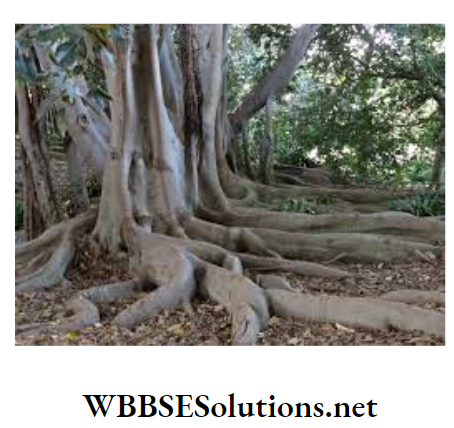
Question 37. Mention two adaptive features of a camel.
Answer:
Two adaptive features of camel are-
- A hump, containing fat, is present on its back.
- RBCs are nucleated, small in size and oval in shape.
Question 38. Mention two adaptations of camels in conserving water.
Answer:
To conserve water, camels have the following adaptive features-
- Camels eliminate highly concentrated urine.
- The mucous membrane of the inner lining of the nasal passage of camels effectively absorbs moisture from the air that the camels exhale.
Darwin’s Theory of Natural Selection and Adaptation
Question 39. Why erythrocytes of camels do not burst due to a huge intake of water after a prolonged thirst?
Answer:
The erythrocytes of camels are oval in shape. Each of these red blood cells has a unique ability. to expand about 240 times of its normal size. Therefore, these cells can withstand a very high osmotic pressure.
Because of this, they do not burst even after a huge intake of water to quench a prolonged thirst. This is a physiological adaptation found in camels to survive in the xeric habitat.
Question 40. Define behavioural adaptation and give an example.
Answer:
Behavioural adaptation:
The behavioural changes of any organism, which help them to survive and better adapt to the environment, are collectively known as behavioural adaptation.
Example-Termite fishing, from termite mounds with thin sticks, made from twigs, is an example of the behavioural adaptation of chimpanzees.
Question 41. What information on chimpanzees were obtained from the research of Jane Goodall?
Answer:
The research on chimpanzees by Jane Goodall revealed that wild chimpanzees show several human-like behaviours. She found that chimpanzees collect termites from termite mounds using thin sticks.
She also noticed that these wild animals consume medicinal plants, when they are infected by parasites.
Question 42. How do wild chimpanzees break hard nutshells?
Answer:
Wild chimpanzees use a piece of rock as an anvil and a strong branch of the tree as a hammer. They keep hard-shelled nuts on the rock and hammer it with the woody tree branch to crack the hard nutshell.
Question 43. What was Karl Von Frisch famous for?
Answer:
Karl Von Frisch:
German scientist, Karl Von Frisch was famous for his studies of communication among honeybees. He was the first to interpret the signals given by scout honeybees to foragers of the hive by performing typical dancing flights to indicate the distance and the direction of the source of food.

Question 44. What information do the scout honeybees pass to the forager bees of the hive by performing a typical bee dance?
Answer:
By performing a typical bee dance, scout honeybees inform forager bees about the distance and direction of the source of food. The dancing pattern even indicates the angle of the food source with the sun.
Question 45. What is meant by the waggle dance of honey-bees?
Answer:
The waggle dance of honey-bees:
If scout honeybees find a source of food at a distance of more than 75 metres from the hive, they perform a typical dancing flight in a certain pattern in front of their hive to pass the message to the forager bees.
They fly in alternate left and right directions to make an ‘8’ shaped course and at the middle portion of the course, they jerk the abdomen. This typical dance is known as the waggle dance.
Behavioral Adaptations in Animals
Chapter 4 Adaptation Multiple Choice Questions And Answers
Question 1. The survival strategy of living organisms is —
- Adaptation
- Reproduction
- Heredity
- Mutation
Answer: 1. Adaptation
Question 2. When attacked by parasites, which of the following animals eats the medicinal plant Aspilia rudis to get rid of it?
- Fish
- Chimp anzee
- Camel
- Tiger
Answer: 2. Chimp anzee
Question 3. The neurally controlled reaction, shown by an organism in response to any environmental signal is —
- Reproduction
- Evolution
- Migration
- Behaviour
Answer: 4. Behaviour
Question 4. Which of the following helps an animal to survive and reproduce?
- Migration
- Evolution
- Mutation
- Adaptation
Answer: 4. Adaptation
Question 5. The structural, behavioural and physiological change of an organism in the course of evolution is called —
- Mutation
- Adjustment
- Adaptation
- Accommodation
Answer: 3. Adaptation
Question 6. An example of morphological adaptation is —
- Production of sweat to cool the body
- Air sacks of pigeon
- Hibernation in frog
- Camel reserve fat in the hump
Answer: 2. Air sacks of pigeon
Question 7. A physiological adaptation Is —
- Air sacks of pigeon
- Pneumatophore of Sundari tree
- Air bladder of rohu fish
- Thom of cactus
Answer: 2. Pneumatophore of Sundari tree
Question 8. The process by which an organism can adjust with the changing environment is known as—
- Adaptation
- Evolution
- Mutation
- Variation
Answer: 1. Adaptation
Question 9. The stem of cactus is called —
- Rhizome
- Phylloclade
- Phyllode
- Underground stem
Answer: 2. Phylloclade
Question 10. The plants growing in the desert are known as —
- Xerophytes
- Hydrophytes
- Epiphytes
- Mesophytes
Answer: 1. Xerophytes
Question 11. Pneumatophores or breathing roots are seen in —
- Sundari (Heritiera sp.) tree
- Cactus
- Pea plant
- Date palm tree
Answer: 1. Sundari (Heritiera sp.) tree
Question 12. In fish, the organ, that helps it to move in different depths of water is —
- Air bladder
- Fins
- Scales
- Tail
Answer: 1. Air bladder
Question 13. The lung activity of pigeons is increased by —
- Keel bone
- Feather
- Air sacs
- Tail
Answer: 3. Air sacs
Question 14. Which is not a water-conserving adaptation of camels?
- Scanty sweating
- Concentrated urination
- Consumption of medicinal plants
- Water storage cells in the stomach
Answer: 3. Consumption of medicinal plants
Question 15. The animal having a nucleus in RBC is
- Camel
- Bird
- Man
- Mice
Answer: 1. Camel
Question 16. Myotome muscles are present in—
- Human
- Snake
- Fish
- Pigeon
Answer: 3. Fish
Question 17. Air sacks are present in —
- Seals
- Pigeons
- Dolphins
- Whales
Answer: 2. Pigeons
Question 18. ‘Waggle’ means—
- Wobble/Shake
- Circle
- Angle
- Swim
Answer: 1. Wobble/Shake
Question 19. Which of the following is not a flight muscle of a pigeon?
- Pectoralis major
- Pectoralis minor
- Myotome
- Coracobrachialis
Answer: 3. Myotome
Question 20. Which of the following plants is not a halophyte?
- Sundari'(Heritiera sp.) tree
- Cactus
- Garan tree
- Geona tree
Answer: 2. Cactus
Question 21. The organs that, help fishes in aquatic locomotion are—
- Lateral line sense organ
- Gills
- Venous heart
- Fins
Answer: 4. Fins
Question 22. The materials, which are difficult for the plants to collect from physiologically dry soil, are—
- CO2 and water
- Minerals and water
- Water and O2
- CO2 and minerals
Answer: 3. Water and O2
Question 23. Identify the animal who communicates information with other members of its own . group through specific dancing patterns regarding the sources of food.
- Chimpanzee
- Cockroach
- Peacock
- Honey bee
Answer: 4. Honey bee
Question 24. Which of the following takes part in waggle dance?
- Queen bee
- Worker bees
- Drones
- King bee
Answer: 2. Worker bees
Question 25. Decide for which of the following purposes bees demonstrate waggle dance—
- Search for reproductive mates
- Inform other worker bees about the direction and the distance of the source of food from the bee hive
- Selecting a place for the construction of the new bee hive
- Avoid attack by probable enemy
Answer: 2. Inform other worker bees about the direction and the distance of the source of food from the bee hive
Question 26. To indicate a distant source of nectar, bees perform—
- Angular dance
- Square dance
- Waggle dance
- Rotation dance
Answer: 3. Waggle dance
Question 27. The plant, which is adapted to physiologically dry soil, is—
- Cactus
- Lotus
- Sundari
- Pine
Answer: 3. Sundari
Question 28. The skin of the animals living in desert areas is—
- Very thin
- Thin
- Moderately thick
- Very thick
Answer: 4. Very thick
Question 29. The sole of the foot is padded with thick, soft muscle in—
- Camel
- Horse
- Buffalo
- Donkey
Answer: 1. Camel
Question 30. The animal, having eyelids lined by long eyelashes, is—
- Dog
- Cat
- Camel
- Fox
Answer: 3. Camel
Question 31. This animal which has a water-conserving system in the body is—
- Cow
- Horse
- Camel
- Chimpanzee
Answer: 3. Camel
Question 32. The main hydrostatic organ of fish is—
- Fin
- Lateral line sense organ
- Operculum
- Air bladder
Answer: 4. Air bladder
Question 33. Which of the following absorbs the gas of the swim bladder of bony fishes?
- Red gland
- Anterior chamber
- Gastric gland
- Rete mirabile
Answer: 4. Rete mirabile
Question 34. The common adaptive feature found in Sundari and cactus to conserve water is—
- Reduction of the number of leaves
- Modification of leaves into spines
- Development of pneumatophore
- Development of cuticle on the epidermis
Answer: 4. Development of cuticle on the epidermis
Question 35. A plant having root buttresses is—
- Garan
- Watermelon
- Cactus
- Mango
Answer: 1. Garan
Question 36. A plant growing in physically dry soil is
- Sundari
- Cactus
- Mango
- Pea plant
Answer: 2. Cactus
Question 37. In which animal, the size of RBC may increase up to 240 times of its normal size?
- Human
- Rat
- Camel
- Chimpanzee
Answer: 3. Camel
Question 38. Who discovered the language of honey bees?
- Niko Tinbergen
- Karl Von Frisch
- Jane Goodall
- Konrad Lorenz
Answer: 2. Karl Von Frisch
Chapter 4 Adaptation Answer In A Single Word Or Sentence
Question 1. To which group of plants does the cactus belong?
Answer: Xerophytes
Question 2. Why do the leaves of cactus modify into spines?
Answer: To prevent excess water loss by transpiration
Question 3. Mention one morphological adaptation of cactus to prevent transpiration.
Answer: The modification of leaves of cactus into the spine
Question 4. In which plant do you find phylloclade?
Answer: In cactus, like Opuntia
Question 5. The leaves of cactus modify into spines. In that case, which organ helps it in photosynthesis?
Answer: The green, thick and succulent stem of cactus helps in photosynthesis.
Question 6. Which part of the cactus grows elaborately to absorb water?
Answer: Root
Question 7. What do you call the changes that occur in organisms to adjust themselves to the changing environment?
Answer: Adaptations
Question 8. What do you call the adaptation that occurs in organisms to adapt themselves in the environment of their origin?
Answer: Primary adaptation
Structural Adaptations in Plants
Question 9. What do you call the adaptation that occurs in organisms to adapt themselves in the environment other than their site of origin?
Answer: Secondary adaptation
Question 10. What do you call the two separate types of adaptations that occur in organisms living in two different environments?
Answer: Dual adaptation
Question 11. Who carried out extensive research on honeybees to find out their language?
Answer: Karl Von Frisch
Question 12. Which behavioural scientist was the first to carry out long research on the behaviour of wild chimpanzees?
Answer: Jane Goodall
Question 13. How many air sacs are associated with the lungs of pigeons?
Answer: Nine
Question 14. Mention one adaptive feature of the Sundari (Heritiera) tree or halophytic plants.
Answer: The presence of pneumatophores
Question 15. Name two plants with pneumatophores.
Answer: Sundari and Garan
Question 16. Name an animal with primary aquatic adaptation.
Answer: Fish
Question 17. Name an animal with secondary aquatic adaptation.
Answer: Whale
Question 18. Which fin of a fish helps to change its direction?
Answer: Tail fin
Question 19. Name an aquatic mammal.
Answer: Whale
Question 20. Name an animal with primary volant adaptation.
Answer: Pigeon
Question 21. Name an animal with secondary volant adaptation.
Answer: Flying squirrel
Question 22. How many paired and unpaired air sacs are present in pigeons?
Answer: A pigeon has 4 paired and 1 unpaired air sac.
Question 23. Which animal can absorb water with its skin?
Answer: A desert lizard, named Moloch Horridus
Question 24. Name a desert mammal.
Answer: Camel
Question 25. Which animals use thin sticks to collect termites from termite mounds?
Answer: Chimpanzees
Question 26. Which chemical plays an important role in controlling the behaviour of honeybees?
Answer: Pheromones
Question 27. Which type of dance do honeybees perform to indicate a source of food at a distance between 50-75 metres?
Answer: Circular dance
Question 28. Which type of dance do honeybees perform to indicate a source of food at a distance of more than 75 metres?
Answer: Waggle dance
Question 29. In which year did Karl Von Frisch receive the Nobel Prize for discovering the language of bee dance?
Answer: 1973
Question 30. How does the course of the waggle dance of honeybees appear?
Answer: The course of the waggle dance of honeybees appears like the English numerical ‘8.
Question 31. Why do honeybees perform waggle dance?
Answer: Honeybees perform a waggle dance to inform other members of the hive about the distance (more than 75 metres) and direction of the source of food, i.e., nectar.
Question 32. Name a plant with root buttresses.
Answer: Sundari (Heritiera fomes)
Question 33. Which portion of the body of a fish possesses the air bladder?
Answer: A fish possesses an air bladder at the upper portion of the abdominal cavity in between the intestine and kidneys.
Question 34. Which animal discharges concentrated urine to conserve body fluid?
Answer: Camel
Question 35. What is the utility of the oval RBCs in camels?
Answer: Oval RBCs of camels can move through fine blood capillaries even with very low water content in plasma.
Question 36. What is pneumatophore?
Answer: The pore on the pneumatophores of halophytes, through which it absorbs oxygen, is called a pneumatophore.
Question 37. To break the nutshells, chimpanzees use hammers and anvils. What do they use as an anvil?
Answer: Rock platform
Question 38. Name a plant with stilt roots.
Answer: Sundari
Question 39. What is a phylloclade?
Answer: Flattened, thick, green, fleshy, photosynthetic stem of the cactus is called a phylloclade.
Question 40. Which portion of the air bladder produces gas?
Answer: Red gland
Chapter 4 Adaptation Fill In The Blanks
Question 1. The leaves of cactus are modified into __________.
Answer: Spines
Question 2. In spite of being a halophyte,__________ trees do not show viviparous germination.
Answer: Sundari
Question 3. The presence of __________ in the eyes of a pigeon provides it with a sharper vision.
Answer: Pectin
Question 4. Sundari is a perennial __________.
Answer: Halophyte
Question 5. Cacti grow in a desert land, therefore, these are called __________ plants.
Answer: Xerophytic
Question 6. The body cells of __________ contain mucilage, hence these plants are capable of conserving excess water.
Answer: Cactus
Question 7. The animals, which inhabit in aquatic environment since their origin are called __________ aquatic animals.
Answer: Primary
Question 8. The animals which possess adaptive features to perform aerial movement are called __________ animals.
Answer: Volant
Question 9. Certain animals can fly for a brief period. These animals are called __________ volant animals.
Answer: Secondary
Question 10. While flying, the __________-shaped body of a pigeon facilitates it to overcome aerial resistance.
Answer: Spindle
Question 11. The ‘V-shaped __________ muscles at two lateral sides of the body help fish in swimming.
Answer: Myotome
Question 12. The air bladder of rohu fish is an example of __________ adaptation.
Answer: Morphological
Question 13. While flying, __________ the of pigeon help to supply extra energy.
Answer: Air sacs
Question 14. Excessive saline soil of the coastal area is called __________ dry soil.
Answer: Physiologically
Life Science Class 10 Wbbse
Question 15. Bee dance is performed only by the __________ bees.
Answer: Worker
Question 16. The __________ of Sundari trees help it in absorbing atmospheric oxygen for respiration.
Answer: Pneumatophores
Question 17. The red blood cells of camel can expand upto __________ times of their normal size.
Answer: 240
Chapter 4 Adaptation State True Or False
Question 1. The air bladder of fish helps it in respiration.
Answer: False
Question 2. The leaf of the cactus is modified into the spine for the reduction of the rate of transpiration.
Answer: True
Question 3. The shape of the course of the ‘waggle dance’ movement of honeybees is like the English numerical ‘8’.
Answer: True
Question 4. The RBCs of camel are small and oval in shape.
Answer: True
Question 5. Rete mirabile is present in the air bladder of fish.
Answer: True
Question 6. Pigeon has 13 air sacs associated with the lungs.
Answer: False
Question 7. If the source of food is 100 meters away, honeybees perform a circular dance.
Answer: False
Question 8. Xerophytic adaptation is seen in pigeons.
Answer: False
Question 9. Pneumatophores are seen in Sundari trees.
Answer: True
Question 10. Flying squirrel is a primary volant animal.
Answer: False
Question 11. Rohu fish is a primary aquatic animal.
Answer: True
Chapter 4 Adaptation Match The Columns
Question 1.
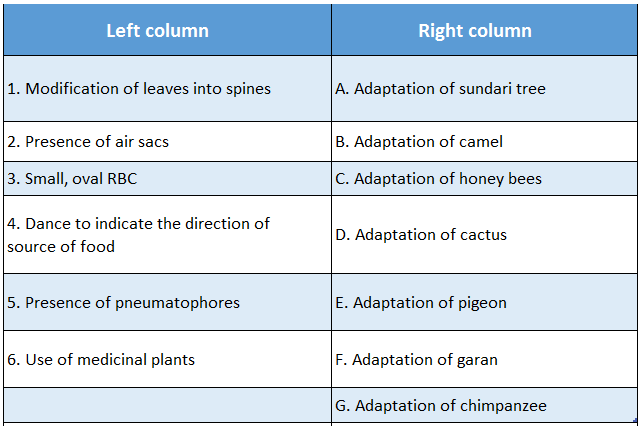
Answer: 1. D, 2. E, 3. B, 4. C, 5. A, 6. G
Question 2.
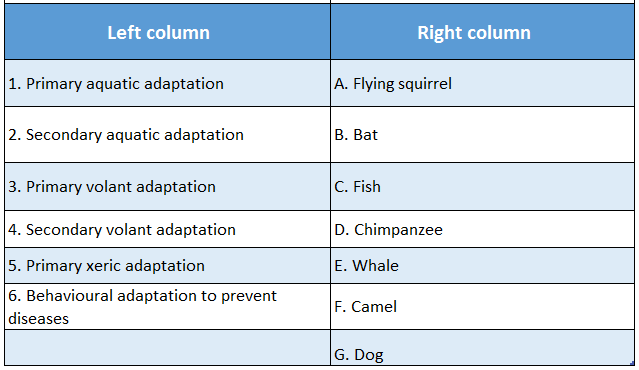
Answer: 1. C, 2. E, 3. B, 4. A, 5. F, 6. D
Chapter 4 Adaptation Find The Odd One Out
Question 1. Phylloclade, Mucilage cells in stem, Storage of excess food, Elaborate root system
Answer: Storage of excess food
Life Science Class 10 Wbbse
Question 2. Pneumatic bones, Air sacs, Air bladder, Absence of urinary bladder
Answer: Air bladder
Question 3. The thick wax coating on the stem, Highly developed root system, Wide and large leaves, and Mucilage cells in the stem
Answer: Wide and large leaves
Question 4. Leaf spine, phylloclade, Well developed root, Pneumatophore
Answer: Pneumatophore
Question 5. Red gland, Air bladder, Rete mirabile, Air sacs
Answer: Air sacs
Physiological Adaptations in Organisms
Question 6. Small and oval RBC, Fat in hump, Presence of air sacs, Xeric adaptation
Answer: The presence of air sacs
Question 7. Round dance, Waggle dance, Use of fishing tool, Scout bee
Answer: Use of the fishing tool
Question 8. Fishing tools, Use of rock as a hammer, Use of herbs, Air bladder
Answer: Air bladder
Chapter 4 Adaptation Fill In The Blanks By Looking At The First Pair
Question 1. Pneumatophore of Sundari tree: Breathing:: Hump of camel: ________________
Answer: Storage of fat
Question 2. Source of food is 50-60 metres away: Circular dance: Source of food is 150 metres away: ________________
Answer: Waggle dance
Question 3. Water sacs in the stomach: To store extra water:: Hump on back: ________________
Answer: To store extra fat
Question 4. Use of long fine sticks: Collection of termites from termite mound:: Use of hardwood and stone: ________________
Answer: Breaking hard nutshell
Question 5. Opuntia: Xerophyte:: Heritiera: ________________
Answer: Halophyte
Question 6. Termite eating dance: Chimpanzee Waggle dance: ________________
Answer: Honey bee
Question 7. Pigeon: Air sack:: Rohu fish: ________________
Answer: Air bladder
Question 8. Salt gland: Salt excretion:: Red gland: ________________
Answer: Gas production
Life Science Class 10 Wbbse
Chapter 4 Adaptation Among The Four Concepts Given Three Of Them Belong To One Find That
Question 1. The elaborate root system, Sparse leaves, Mucilage containing cells in the stem, and Xerophytic adaptation.
Answer: Xerophytic adaptation
Question 2. Pneumatic bones, Volant adaptation, Additional air sacs with lungs, Absence of urinary bladder and rectum.
Answer: Volant adaptation
Question 3. Water sacs in the stomach, Water conservation, Thick hairy skin, Concentrated urine.
Answer: Water conservation
Question 4. Air bladder, Red gland, Rete mirabile, Pneumatic duct
Answer: Air bladder
Question 5. Mangrove plant, Heritiera sp., Rhizophora sp., Pneumataphore
Answer: Mangrove plant
Question 6. Food collection, Animal behaviour, Round dance, Waggle dance
Answer: Animal behaviour
Chapter 4 Adaptation Advanced Questions And Answers
Question 1. What is the abiogenetic theory of life?
Answer:
Abiogenetic theory of life
Greek philosopher Aristotle and Spanish physiologist, Van Helmont separately opined that life has originated spontaneously from inorganic substances in the earth. This theory is called the abiogenetic theory or biopoiesis.
Question 2. What is the venous heart? Give example.
Answer:
Venous heart
The heart through which only de-oxygenated blood is transported is called the venous heart.
Example-Heart of fish.
Question 3. Can Darwinian selection theory explain antibiotic resistance, a property of bacteria? Support your answer with reasons.
Answer:
Yes. the antibiotic resistance property of bacteria can be explained by Darwinian selection theory. According to Darwin, individuals with favourable variations are better adapted than individuals with less favourable variations.
Darwin stated that nature selects the individuals with favourable variation as these individuals are better evolved to survive in the existing environment.
When a bacterial population comes in contact with antibiotics, those which are sensitive to antibiotic dies, whereas a few bacterial colonies that are resistant to an antibiotic, survive.
Hence, the resistant bacteria multiply quickly, thereby increasing their number. Here it is observed that the advantage of an individual over another helps in the struggle for existence.
Question 4. Define adaptive radiation.
Answer:
Adaptive radiation
The process of rapid diversification of an organism from an ancestral species into a new form, during the change of environment which provides new resources or alters biotic interaction, or opens a new environmental niche, is termed as adaptive radiation in evolutionary biology.
